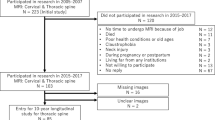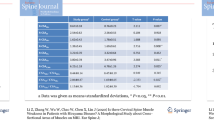Abstract
There has been no prospective study on age-related changes of the extensor muscles of the cervical spine in healthy subjects. This study was conducted to elucidate any association between the changes in cross-sectional area of the extensor muscles of the cervical spine on MRIs and cervical disc degeneration or the development of clinical symptoms. Sixty-two subjects who underwent MR imaging by a 1.5-Tesla machine between 1993 and 1996 as asymptomatic volunteers in a previous study were recruited again 10 years later for this follow-up study. The mean interval between the studies was 11.0 ± 0.7 years. The cross-sectional areas of the multifidus, semispinalis cervicis, semispinalis capitis, and splenius capitis at C3–C4, C4–C5, and C5–C6 intervertebral levels were measured on T2-weighted axial images using Image J 1.42. The mean cross-sectional areas of the deep extensor muscles were 1,396.8 ± 337.6 mm2 at the C3–C4 level, 1,514.7 ± 381.0 mm2 at the C4–C5 level, and 1,542.8 ± 373.5 mm2 at the C5–C6 level in the previous investigation. The cross-sectional areas were 1,498.7 ± 374.4 mm2 at the C3–C4 level, 1,569.9 ± 390.9 mm2 at the C4–C5 level, and 1,599.6 ± 364.3 mm2 at the 10-year follow-up. An increase in the cross-sectional area of the muscles was more frequently observed in subjects in their tens to thirties in the initial study, while a decrease was more frequently observed in those in their forties and older in the initial study. Disc degeneration was not correlated with a change in extensor muscle volume. Development of shoulder stiffness during follow-up was significantly negatively correlated with a change in the cross-sectional area of the deep extensor muscles.



Similar content being viewed by others
References
Battie MC, Videman T, Kaprio J et al (2009) The Twin Spine Study: contributions to a changing view of disc degeneration. Spine J 9:47–59
Booth FW, Weeden SH, Tseng BS (1994) Effect of aging on human skeletal muscle and motor function. Med Sci Sports Exerc 26:556–560
Cagnie B, D’Hooge R, Achten E et al (2010) A magnetic resonance imaging investigation into the function of the deep cervical flexors during the performance of craniocervical flexion. J Manipulative Physiol Ther 33:286–291
Chiba K, Ogawa Y, Ishii K et al (2006) Long-term results of expansive open-door laminoplasty for cervical myelopathy—average 14-year follow-up study. Spine 31:2998–3005
Cohn SH, Vartsky D, Yasumura S et al (1980) Compartmental body composition based on total-body nitrogen, potassium, and calcium. Am J Physiol 239:524–530
Conley MS, Meyer RA, Bloomberg JJ et al (1995) Noninvasive analysis of human neck muscle function. Spine 20:2505–2512
Elliott J, Jull G, Noteboom JT et al (2006) Fatty infiltration in the cervical extensor muscles in persistent whiplash-associated disorders: a magnetic resonance imaging analysis. Spine 31:847–855
Elliott JM, Jull GA, Noteboom JT et al (2007) Magnetic resonance imaging study of cross-sectional area of the cervical extensor musculature in an asymptomatic cohort. Clin Anat 20:35–40
Elliott J, Jull G, Noteboom JT et al (2008) MRI study of the cross-sectional area for the cervical extensor musculature in patients with persistent whiplash associated disorders (WAD). Man Ther 13:258–265
Frontera WR, Hughes VA, Lutz KJ et al (1991) A cross-sectional study of muscle strength and mass in 45- to 78-yr-old men and women. J Appl Physiol 71:644–650
Gore DR (2001) Roentgengraphic findings in the cervical spine in asymptomatic persons: a ten-year follow-up. Spine 26:2463–2466
Gore DR, Sepic SB, Gardner GM (1986) Roentgengraphic findings of the cervical spine in asymptomatic people. Spine 11:521–524
Herkowitz HN, Garfin SR, Eismont FJ et al (2006) Rothman-Simeone, the spine, 5th edn. Saunders-Elsevier, Philadelphia
Ichihara D, Okada E, Chiba K (2009) Longitudinal magnetic resonance imaging study on whiplash injury patients: minimum 10-year follow-up. J Orthop Sci 14:602–610
Iizuka H, Shimizu T, Tateno K et al (2001) Extensor musculature of the cervical spine after laminoplasty: morphologic evaluation by coronal view of the magnetic resonance image. Spine 26:2220–2226
Iizuka H, Nakajima T, Iizuka Y et al (2007) Cervical malalignment after laminoplasty: relationship to deep extensor musculature of the cervical spine and neurological outcome. J Neurosurg Spine 7:610–614
Janssen I, Heymsfield SB, Wang ZM et al (2000) Skeletal muscle mass and distribution in 468 men and women aged 18–88 yr. J Appl Physiol 89:81–88
Kamper SJ, Rebbeck TJ, Maher CG et al (2008) Course and prognostic factors of whiplash: a systematic review and meta-analysis. Pain 138:617–629
Kotani Y, Abumi K, Ito M et al (2009) Minimum 2-year outcome of cervical laminoplasty with deep extensor muscle-preserving approach: impact on cervical spine function and quality of life. Eur Spine J 18:663–671
Larsson L, Ansved T (1995) Effects of ageing on the motor unit. Prog Neurobiol 45:397–458
Lehto IJ, Tertti MO, Komu ME et al (1994) Age-related MRI changes at 0.1 T in cervical discs in asymptomatic subjects. Neuroradiology 36:49–53
Matsumoto M, Fujimura Y, Suzuki N (1998) MRI of cervical intervertebral discs in asymptomatic subjects. J Bone Joint Surg Br 80:19–24
Nolan JP Jr, Sherk HH (1988) Biomechanical evaluation of the extensor musculature of the cervical spine. Spine 13:9–11
Okada E, Matsumoto M, Ichihara D et al (2009) Aging of the cervical spine in healthy volunteers: a 10-year longitudinal magnetic resonance imaging study. Spine 34:706–712
Okada E, Matsumoto M, Ichihara D et al (2010) Development of stiff shoulder in asymptomatic volunteers during ten-year follow-up in Japan. J Back Musculoskelet Rehabil 23:69–75
Panjabi MM, Cholewicki J, Nibu K et al (1998) Critical load of the human cervical spine: an in vitro experimental study. Clin Biomech 13:11–17
Parkkola R, Kormano M (1992) Lumbar disc and back muscle degeneration on MRI: correlation to age and body mass. J Spinal Disord 5:86–92
Parkkola R, Rytökoski U, Kormano M (1993) Magnetic resonance imaging of the discs and trunk muscles in patients with chronic low back pain and healthy control subjects. Spine 18:830–836
Schuenke M, Schulte E, Schumacher U (2006) General anatomy and musculoskeletal system. Thieme, Stuttgart
Shiraishi T (2002) Skip laminectomy—a new treatment for cervical spondylotic myelopathy, preserving bilateral muscular attachments to the spinous processes: a preliminary report. Spine J 2:108–115
Shiraishi T, Fukuda K, Yato Y et al (2003) Results of skip laminectomy-minimum 2-year follow-up study compared with open-door laminoplasty. Spine 28:2667–2672
Takagishi K, Hoshino Y, Ide J et al (2008) Project study of Japan Ortheapedic Association on stiff shoulder. J Jpn Orthop Assoc 82:901–911 (in Japanese)
Takeuchi K, Yokoyama T, Ono A et al (2007) Cervical range of motion and alignment after laminoplasty preserving or reattaching the semispinalis cervicis inserted into axis. J Spinal Disord Tech 20:571–576
Tsuji T, Asazuma T, Masuoka K et al (2007) Retrospective cohort study between selective and standard C3-7 laminoplasty. Minimum 2-year follow-up study. Eur Spine J 16:2072–2077
Acknowledgments
This study was supported by a grant from the General Insurance Association of Japan. We thank Dr. Takeshi Ikegami of the Department of Orthopaedic Surgery of Keio University, Dr. Kota Watanabe M.D. of the Advanced Therapy for Spine and Spinal Cord Disorders, Keio University, Takeshi Hashimoto M.D. of the Department of Orthopaedic Surgery, Keio University Tsukigase Rehabilitation Center, Dr. Tomoo Inoue of the Department of Orthopaedic Surgery, Kyorin University, Dr. Masahiko Watanabe of the Department of Orthopaedic Surgery, Tokai University, Dr. Yoshiji Suzuki of the Omaezaki Municipal Hospital, and Mr. Toshio Watanabe of the Central Radiotechnology Department of Keio University Hospital for their help with this study.
Conflict of interest
Morio Matsumoto receives a consulting fee from Medtronic Japan and Kyoei Fire & Marine Insurance and has received an honorarium from the General Insurance Association of Japan for giving a workshop. Kazuhiro Chiba has received an honorarium from the General Insurance Association of Japan for giving a workshop. The other authors have no conflict of interest.
Author information
Authors and Affiliations
Corresponding author
Rights and permissions
About this article
Cite this article
Okada, E., Matsumoto, M., Ichihara, D. et al. Cross-sectional area of posterior extensor muscles of the cervical spine in asymptomatic subjects: a 10-year longitudinal magnetic resonance imaging study. Eur Spine J 20, 1567–1573 (2011). https://doi.org/10.1007/s00586-011-1774-x
Received:
Revised:
Accepted:
Published:
Issue Date:
DOI: https://doi.org/10.1007/s00586-011-1774-x




